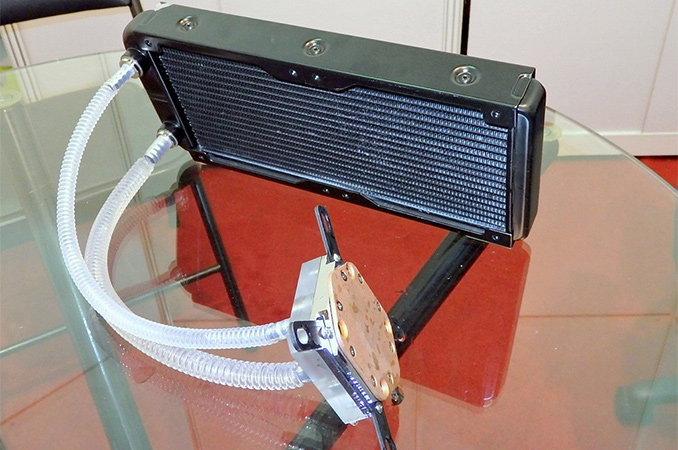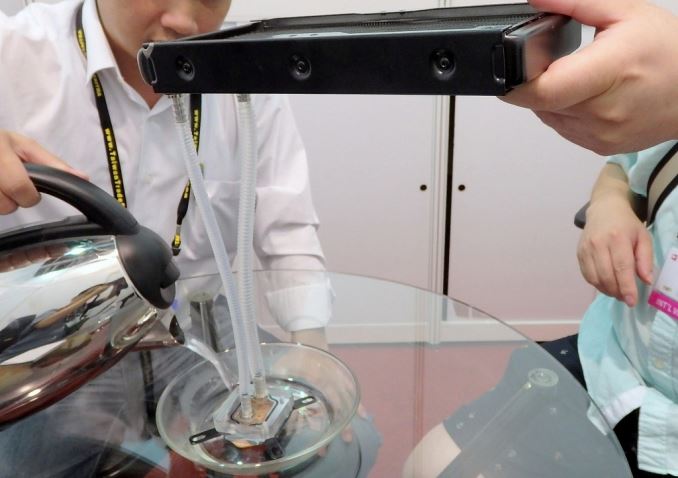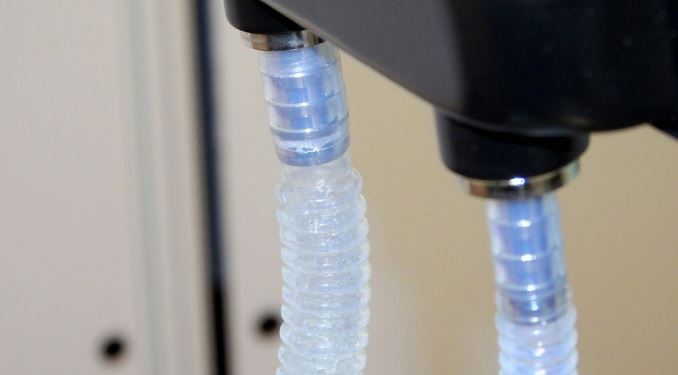Raijintek Shows Off Pumpless Liquid Cooling System
by Anton Shilov on June 3, 2016 10:00 AM EST
In the recent year’s all-in-one liquid cooling solutions gained significant popularity thanks to efficiency and quieter operation. However, even with those improvements, a closed loop cooler still needs a pump to enable circulation of liquid as well as at least one fan to maximize cooling efficiency. Seen as the next step, pumpless liquid cooling systems have been discussed by various developers for a while, and Raijintek demonstrated one at Computex 2016.
The prototype of Raijintek’s pumpless liquid cooling system is comprised of a completely passive CPU/GPU water block with a copper base (featuring a system of very thin channels to maximize heat dissipating surface area) with two nozzles of different diameter, two tubes as well as a radiator (images are by Hermitage Akihabara). The LCS is filled with a customized coolant, which has evaporation point of around 40°C to 50°C. Once the CPU or the GPU gets hot enough, the coolant turns into vapor and streams to the radiator through one of the tubes where it condenses back to liquid, whereas the cool coolant streams back to the water block.
Raijintek's prototype of a pumpless LCS. Image by Hermitage Akihabara.
Natural processes enable the circulation and the liquid cooling system is nearly noiseless (keep in mind that physical processes like water circulation create noises). In the best-case scenario, the higher is the temperature of the chip cooled down by such a LCS, the faster is the circulation. The theoretical limit of TDP that Raijintek’s prototype can handle is unclear, but different reports point to over 200 W, which is in line with traditional high-end and AIO liquid coolers. At Computex, the manufacturer demonstrated the prototype without any fans, but the radiator can be equipped with two of them to maximize cooling performance. While fans are not compulsory, there is a requirement, though: the radiator always has to be installed above the water block, which is something harder to do in small form-factor PCs.
Raijintek's prototype of a pumpless LCS. Image by Hermitage Akihabara.
The advantages of pumpless LCS are obvious: it does not have moving parts and therefore is more reliable than traditional systems; it does not generate as much noise and does not use power, provided that the coolant is cheap enough, the cost of a pumpless LCS should be lower than the cost of a traditional closed-loop liquid cooling system. On the other hand, it is completely unclear how the liquid with a very low evaporation point handles high TDPs when placed in a hot external environment. Besides, temperature of such liquid should remain below 40°C at all times (so, you are not going to use such device in Qatar, where temperatures above 40°C are common). Finally, the LCS must be perfectly sealed to maintain vacuum inside because any slight imbalance of pressure inside will harm its operation, a requirement that potentially increases the cost of the device.
Raijintek's prototype of a pumpless LCS. Image by Hermitage Akihabara.
Raijintek has invested a lot in development of its pumpless LCS over the years. In fact, the first prototype was ready back last year, but the company decided not to demonstrate it, but patent the technology in major markets first. Given the price of the new coolant as well as a new manufacturing process required to build pumpless LCS with vacuum inside, the price of the final product will not be low and may be actually higher compared to traditional AIO liquid coolers.
It is interesting to note that Raijintek is not the first to showcase a pumpless closed-loop liquid cooling system. Back in 2014, Silverstone demonstrated its prototype at Computex, but so far the company has not released it commercially.
Sources: BitTech, Hermitage Akihabara, TechPowerUp, 3DNews.













65 Comments
View All Comments
Ian Cutress - Friday, June 3, 2016 - link
Didn't 3M use a coolant like this for a sealed PC without a heatsink and a peltier cooler a number of years back? I remember the coolant being something like $300 a gallon, some medium chain organic bromide compound Iirc? There was a video at one pointImSpartacus - Friday, June 3, 2016 - link
Why does the cost of coolant matter? Are you refilling it from time to time?I intuitively assumed that this would be completely sealed for the life of the product as it seems like the dram quality matters.
Also, how much coolant would this kind of cooler utilize at one time? It looks like it might be like a quart or less. Certainly not cheap at $300/gal, but it might be marketable.
DCRussian - Friday, June 3, 2016 - link
The cost of coolant matters as it will directly affect the price of the AIO unit as they have to be pre-filled by the manufacturer. Besides, if you ever do need to refill it by yourself, if that's even an option, then the cost matters if you can only buy it in set quantities.BurntMyBacon - Friday, June 3, 2016 - link
@DCRussian: "Besides, if you ever do need to refill it by yourself, if that's even an option, ..."It's not. You can't guarantee the required vacuum. There will most certainly be a warranty void if opened stipulation. They aren't going to provide the coolant to people that they don't want messing with it in the first place.
The rest of your point stands, but it sounds like ImSpartacus addressed that.
Alexvrb - Saturday, June 4, 2016 - link
If they equip it with the right fittings I can guarantee a vacuum... :PBurntMyBacon - Monday, June 6, 2016 - link
I was referring to customers in general. There are sure to be some people who can do it, but even if you have the right equipment, I think you'll have a hard time getting them to warranty your product.Alexvrb - Wednesday, June 8, 2016 - link
If you're going to any lengths to service the system yourself, chances are it's out of warranty. Either way the only point of contention was "you can't guarantee the vacuum" and even then that was only with the stipulation that it would need a useful port. Not that it matters because I can guarantee they will make it non-serviceable.saratoga4 - Friday, June 3, 2016 - link
You can't refill something like this, it can only be filled under vacuum using special equipment. Once air gets in it's basically dead.The cost of the coolant won't matter very much because you only use a small amount of it, and most likely the coolant is just alcohol or water alcohol mix.
bananaforscale - Saturday, June 4, 2016 - link
Syringe through a silicone or similar cap that seals after you withdraw the needle. Problem solved.Jorsher - Monday, June 6, 2016 - link
A vacuum will decrease if you add more to the system. A vacuum will attempt to equalize pressure with the syringe.It's not quite as simple as you think.